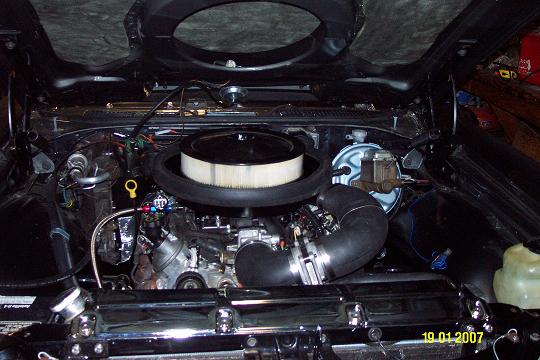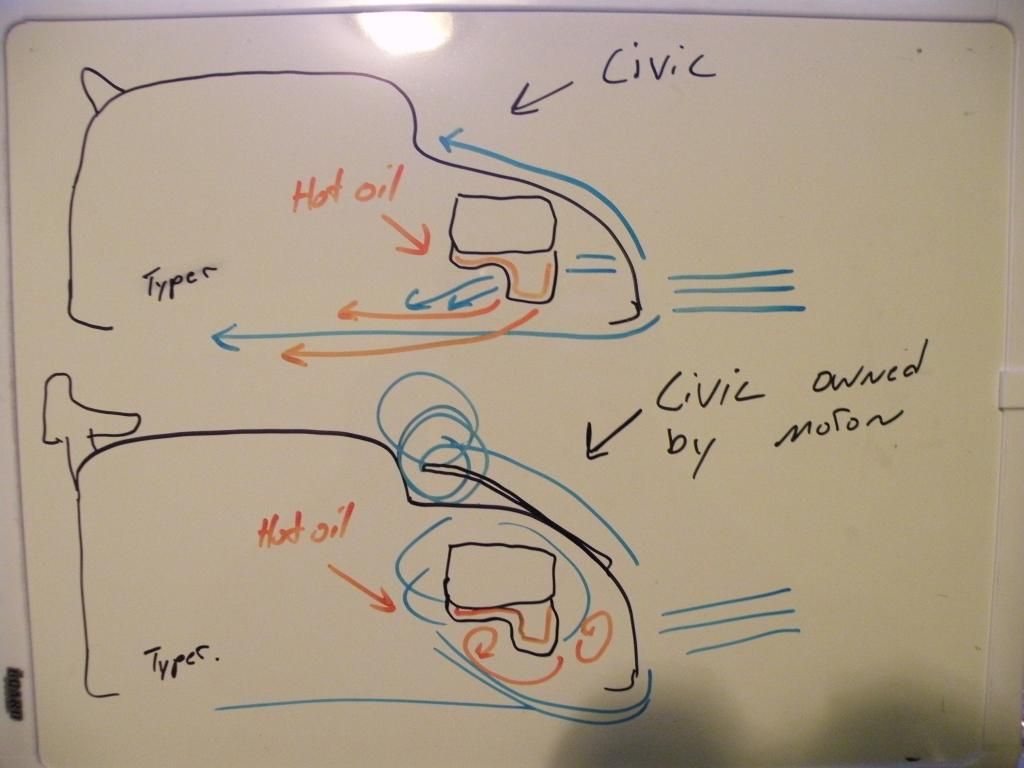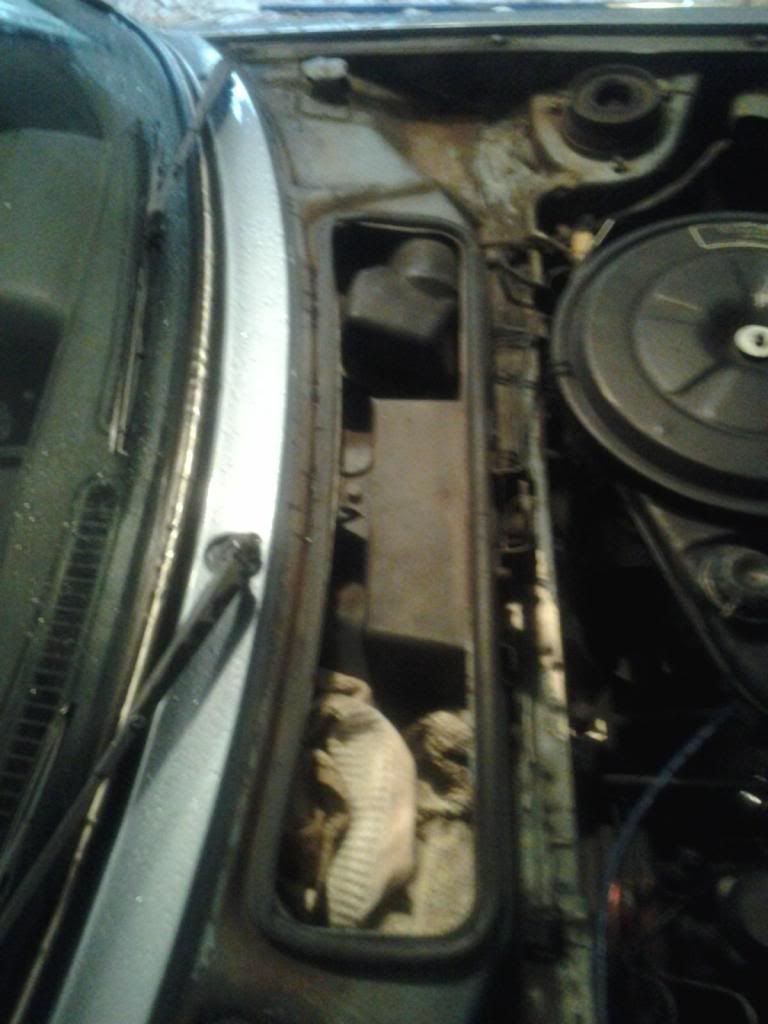OK, I'll try to keep my opinions to a minimum here. I see a lot of people with this "mod" who honestly believe it is functional and "cools better". Anyone who believes this is full of sh*t. Anyone who ever says "well I noticed a difference" is also full of sh*t. This is not my opinion, it's a fact. I'll also try to keep this on the simple side of thins by not getting into crazy detail, formulas or physics. Besides, I'm not a physicist or have taken any fluid dynamics classes. But I'd like to think I have a good general understanding of the basic principals...
Also, ONE VERY IMPORTANT PART OF ALL OF THIS is how INCREDIBLY IMPORTANT IT IS TO RETAIN ANY FACTORY PLASTIC UNDERTRAYS on your car at ALL TIMES.
I've seen too many cars missing such a crucial element to keeping your car running properly.
Let's start with a basic diagram showing airflow over your typical car. This can be applied just about 99% of cars on the road. So unless you have that six-figure supercar, this applies to you.
Here we have a good tool to show basic high and low pressure zones on a car. Some of them are obvious, like at the front bumper where air is "slammed" against the vehicle at a perpendicular angle. This is caused by air stacking up as it searches for the path of least resistance. High pressure is created by air being compressed, squeezed, as it flows over/around/through an object. Just as we have high pressure, we have low pressure. Low pressure is caused by air being decompressed...the term vacuum is a common way to explain low pressure since we all know what that is. So we can see in the picture above how air is compressed at the front of the car at the opening to the heat exchangers (i.e. radiator, a/c condenser, oil cooler etc...).
So how does my radiator work? It's just air moving through the grille and over the engine, right? Yes and no. Because air is compressed in front of the car by both the flat surfaces of the bumper and by the resistance of what is behind the opening, you get a high pressure zone. Keep this in mind- air does not like being compressed. Do you like to try to shove yourself into an elevator with 9 other people that seems like it can only hold 5 people? Same general idea. Since your engine compartment in your average front-engine car is a rather large, open space compared to the opening in the bumper, the air molecules get a chance to slow down and relax....because of low pressure.
So let's go over a simplified version of how your front bumper, heat exchangers, hood, windshield and engine undertray all work together....and why hood risers counteract the system (as in, why they are bad).
Let's analyze this quick picture I made. Ignore the fact the car is modified with aftermarket aerodynamic parts (splitter, canards and wing).
Let me explain some of the elements of this picture first- READ CAREFULLY. Think of your engine compartment as a box- hood on top, firewall on back, inner fenders on the sides, the radiator (heat exchangers) up front and the undertray on the bottom. Clearly it is not a sealed box, and there are opening in this box with very specific functions.
- The RED box represents the firewall at the back of the engine bay.
- The GREEN box represents your VERY IMPORTANT engine undertray.
- The YELLOW box represents your heat exchangers.
- The BLUE box represents the general engine compartment.
- The LIGHT BLUE LINES are representing airflow that is low to the ground and goes UNDER the car.
- The PURPLE LINES represent airflow that will go into the front bumper opening.
- The WHITE BOXES in front of the car represent the boundaries between where air goes under the car, into the bumper opening and over the hood/car.
Take a minute and match each description to its location.
So, with everything functioning normally and working together, air flows over the car, under the car and through the heat exchangers and into the engine compartment. As air impacts the front opening and meets resistance from the heat exchangers, it "stacks up" and creates a high pressure zone. Air does not like to be compressed (high pressure) and will seek out an area where it is not being forced to reside. Since the heat exchangers are designed to allow air to pass through them, it does and enters the engine compartment, which is larger in volume than the area in front of the car. Since the air gets to "relax", so to say, after entering the engine compartment, it becomes a low-pressure zone. This is also because air is only entering the engine compartment through the front opening. The front undertray keeps the air flowing through the heat exchangers and the air flowing under the car separate. What happens here is the air moving under the car is moving much faster than the air in the engine compartment and because of the lack of obstruction under the car, the air flows easily toward the back of the car. Since the undertray extends from the front bumper and past the heat exchangers, the fast moving air under the car creates what is called a "venturi effect" under the engine compartment. This is where the fast moving air more or less "sucks" air out from another area. Since the air moving under the car really isn't compressed, it's not a high-pressure zone, so that air does not want to fill the low-pressure area in the engine compartment and keeps flowing toward the back of the car.
Here is a visual example of this. The blue arrows/lines represent the flow mentioned above.
Now we go back to the first picture posted with the high and low pressure areas depicted. Notice the base of the windshield? See how it's red and orange just like the front of the bumper? Have you figured out now that is is also a high-pressure area? Good! Pretty much all cars have a piece of rubber stripping at the back of the hood over the firewall area. Now can we guess what this does? If you guess "it keeps air from passing through, you have won a pat on the back. Go ahead, take a moment to reach over your shoulder and do it. Or maybe you prever a virtual high-five. In this case, place your hand on the monitor at this time and pretend someone is on the other side doing the same. OK. So what happens if we decide to eliminate this seal that is blocking the high-pressure air from forcing itself into the engine compartment? Well, just that- the high-pressure buildup at the base of the windshield (also known as the cowl area) will migrate to the low-pressure area of the engine compartment.
How is this a problem?
Well, we already have one high-pressure zone feeding the low-pressure zone of the engine compartment. Adding a second "feed" of high-pressure effectively reduces the flow of the other high to low pressure zone because now the low-pressure area of the engine compartment is not as much of a low-pressure zone. This means the air at the opening of the bumper has more resistance to getting through the heat exchangers and into the engine compartment, and finds a lower path of resistance either over or under the car....but NOT through the heat exchangers. Reduced flow over the exchangers means less heat is removed from them.
What does this look like? How about another picture...
Here you can see the high-pressure area in the cowl in RED. Opening a path of least resistance (hood risers) allows the air to move into the engine compartment, when it exits out under the car. Because we are allowing high-pressure into the engine compartment with little resistance (direct path), the opening up front (which has more resistance due to the heat exchangers) becomes less effective. It seems popular belief is that the air moving into the engine compartment from the bumper opening has enough pressure and flow to significantly pressureize the engine bay with air and that opening the back of the hood allows the air to be pushed up and out the back. THIS IS NOT TRUE.
THIS IS A LIE. A MISCONCEPTION. IT DOES NOT WORK LIKE THIS-
So now you know why hood riders are for ricers and making your car look like it was in an accident.
I can only really think of one scenario where someone could "make sense" of the wrong picture posted above. That would be like washing the engine bay and going for a drive and while sitting at a stop and seeing steam/condensation on the lower part of the windshield coming from the engine bay. Or maybe when driving in cold, damp weather and coming to a stop and seeing steam form at the bottom of the windshield on the outside where warm, moist air from the engine bay is contacting the windshield. Either way, this is completely different than when a car is moving. When sitting still, heat rises and is trying to escape out the top of the hood. Since the cowl is generally higher than the front of the hood, heat wants to escape from here the most (while sitting still...mind you). A poor seal along the cowl will make this more noticeable. This is because there is no high and low-pressure areas affecting the car at the time. Furthermore, if the cooling fans come on while sitting still, they do create a slightly higher pressure area in the engine compartment and some air will inevitable come out of the cowl area...mostly because it is hot air and hot air rises.
Here we can see a good example of what happens when a space is created at the cowl of the windshield. You can see the strings being sucked into the cowl area, not blown up and out. Without isolating this air, as in letting in just rush into the engine bay, more pressure is created up front and less air moves through the heat exchangers.














 Reply With Quote
Reply With Quote















 [/URL]
[/URL]



 ..
..
 fully equipped, interfooler and all.
fully equipped, interfooler and all.